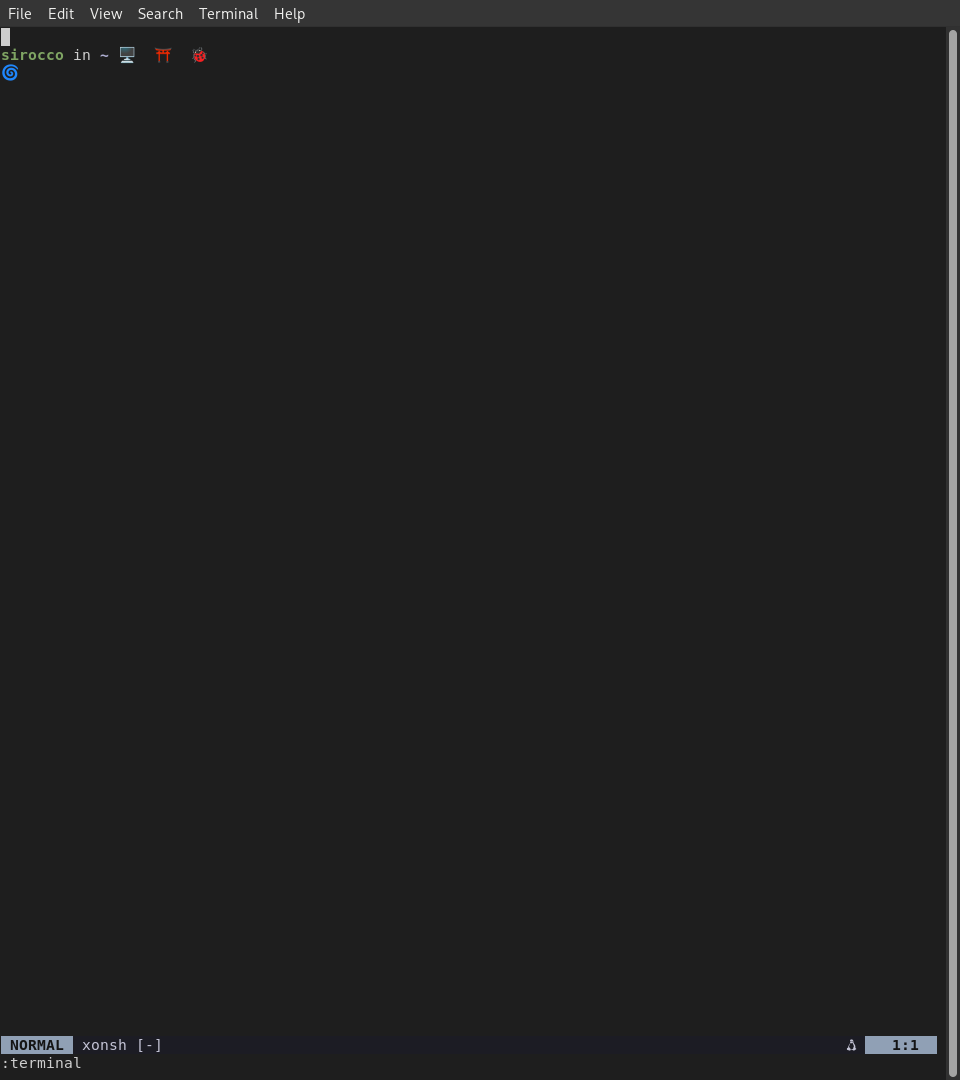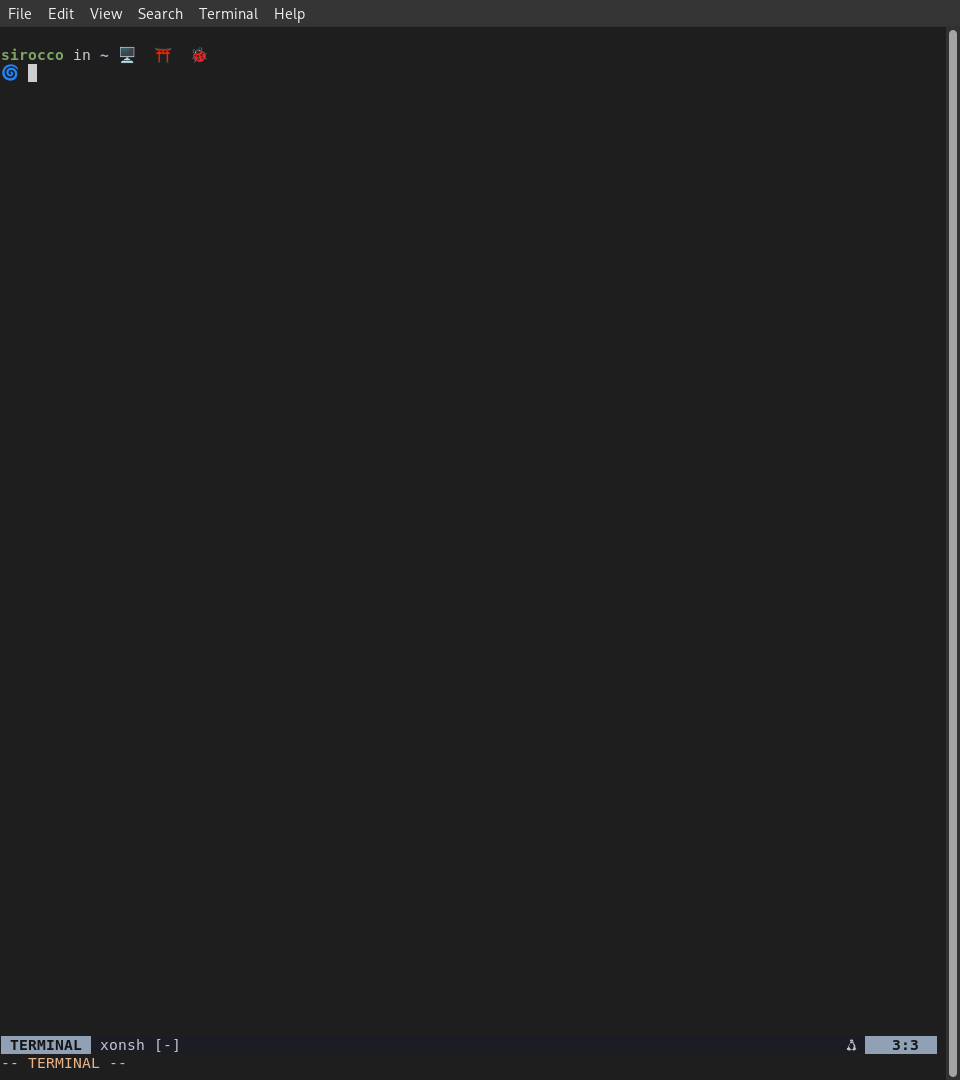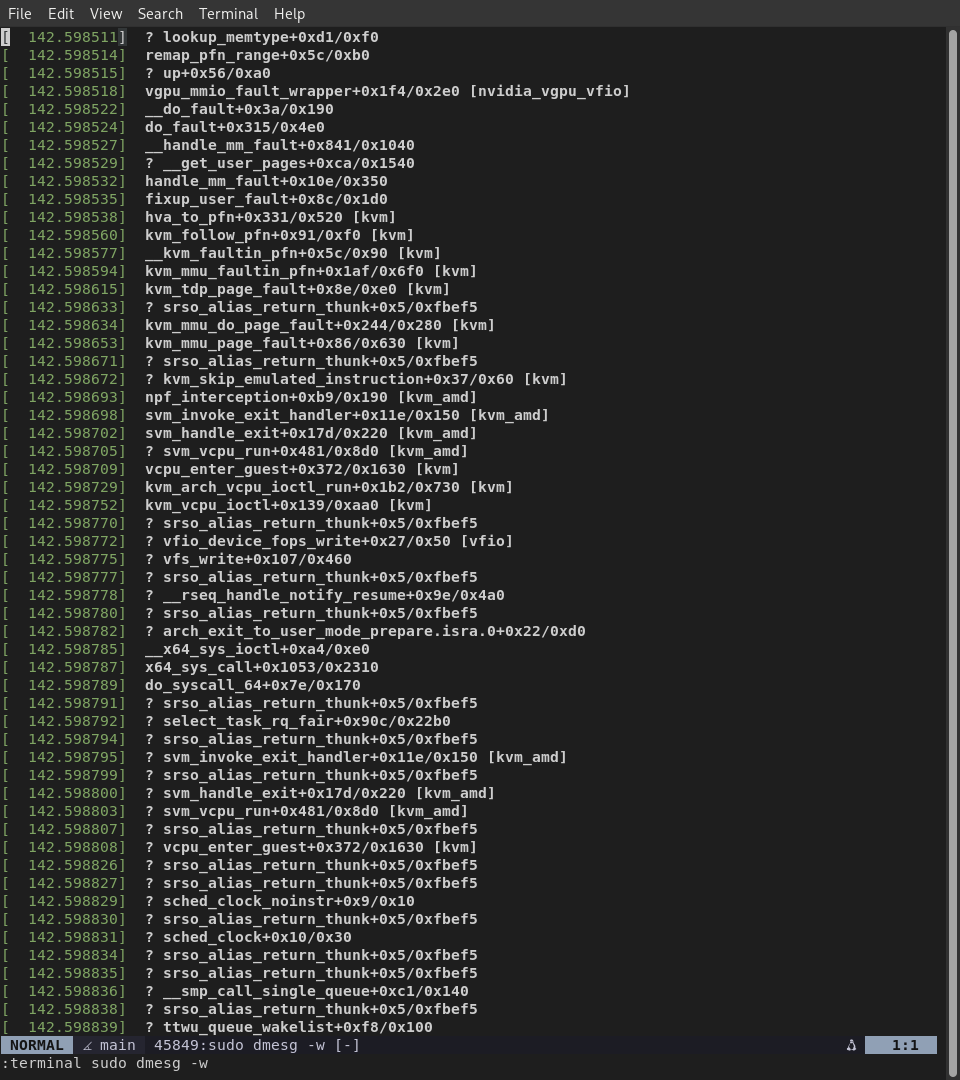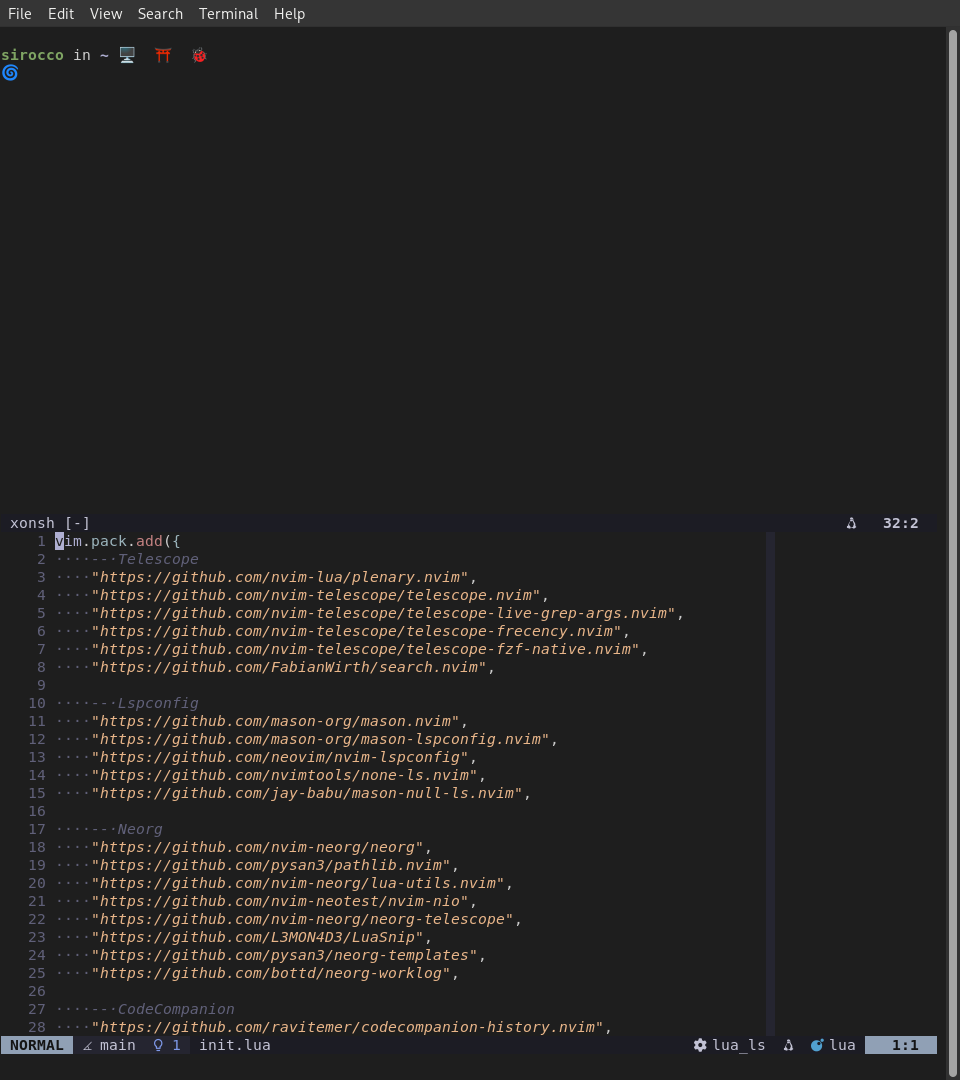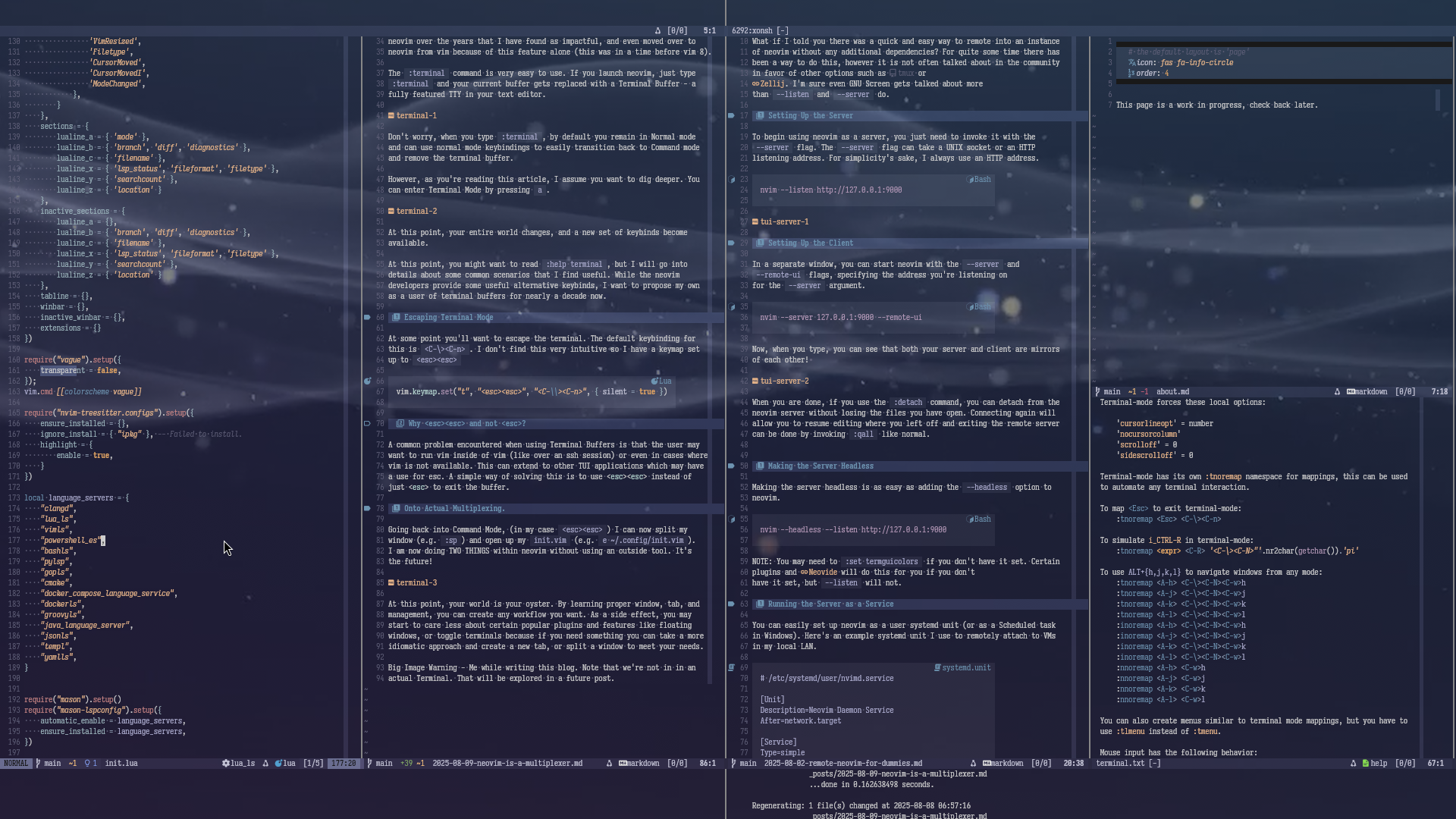Neovim is a Multiplexer
Why use two tools when you only need one?
Introduction
In my last post, I detailed the use of Neovim’s client / server architecture with respect to remotely accessing an instance of Neovim. I don’t think I did an adequate job at expressing the “why”, and that was partially intentional. There are a series of topics I’d like to write up which cover how I personally use Neovim, and the intention is to slowly build up a development environment where one tool rules them all.
In this post, I plan to talk about :terminal. While :terminal is popular in some contexts, it’s usually wapped up in some kind of plugin e.g. toggleterm.nvim to help the user with very specific use cases (“What if I need a single terminal to open on demand?”). I’ve used :terminal since its inception and I’d like to present the way I personally use the command.
Tangent - Way back when the feature was new, I even created my own floating terminal plugin. While cute at the time, I don’t find tools like this very helpful as they distract from the workflow defined in my session file.
So What is So Special About :terminal?
:terminal is something I am passionate about because my day revolves around its existence. I don’t think there’s any singular feature added to vim or Neovim over the years that I have found as impactful, and even moved over to Neovim from vim because of this feature alone (this was in a time before vim 8).
The :terminal command is very easy to use. If you launch Neovim, just type :terminal and your current buffer gets replaced with a Terminal Buffer - a fully featured TTY in your text editor.
Don’t worry, when you type :terminal, by default you remain in Normal mode and can use normal mode keybindings to easily transition back to Command mode and remove the terminal buffer.
However, as you’re reading this article, I assume you want to dig deeper. You can enter Terminal Mode by pressing a.
At this point, your entire world changes, and a new set of keybinds become available.
At this point, you might want to read :help terminal, but I will go into details about some common scenarios that I find useful. While the Neovim developers provide some useful alternative keybinds, I want to propose at least one as a user of terminal buffers for nearly a decade now.
Escaping Terminal Mode
At some point you’ll want to escape the terminal. The default keybinding for this is <C-\><C-n>. I don’t find this very intuitive so I have a keymap set up to <esc><esc>
1
vim.keymap.set("t", "<esc><esc>", "<C-\\><C-n>", { silent = true })
Why <esc><esc> and not <esc>?
A common problem encountered when using Terminal Buffers is that the user may want to run vim inside of vim (like over an ssh session) or even in cases where vim is not available. This can extend to other TUI applications which may have a use for esc. A simple way of solving this is to use <esc><esc> instead of just <esc> to exit the buffer.
:terminal Can be Used to Spawn More Than Just Your Primary Shell
You can execute arbitrary commands with :terminal. For example, I can run :terminal sudo dmesg -w to spawn dmesg in my current buffer. Exiting dmesg with <C-c> closes the buffer.
Note: It’s only a warning - my kernel did not crash.
Onto Actual Multiplexing.
Going back into Command Mode, (in my case <esc><esc>) I can now split my window (e.g. :sp) and open up my init.vim (e.g. e ~/.config/init.vim). I am now doing TWO THINGS within Neovim without using an outside tool. It’s the future!
At this point, your world is your oyster. By learning proper window, tab, and management, you can create any workflow you want. As a side effect, you may start to care less about certain popular plugins and features like floating windows, or toggle terminals because if you need something you can take a more idiomatic approach and create a new tab, or split a window to meet your needs.
Now a screenshot of writing this blog post. Note that we’re not in in an actual terminal (we’re actually in Neovide). That will be explored in a future post.
What are the Downsides?
Like with all things, there are of course downsides.
Lack of Terminal Softwrap
There is an open github issue around being able to soft wrap terminal buffers. Right now if you want to yank text out of a buffer, the text will have hard line breaks in it. This can be very annoying if you’re like me and tail a lot of logs and want to yank output.
There are currently several hacks and workarounds for this issue, but I usually just fix up the yanked lines manually.
The Strong Mindshare of Competing Products.
As addressed in my previous post, both tmux and Zellij have significant mindshare in the neovim community. In the past, I have tried to explain why these tools fail to solve the problem that terminal buffers solve (one tool is easier to use than two) but as many people entering the community learn these multiplexers before they learn buffer management (and :terminal), and they don’t see a desire to abandon things they already know. Over the years I’ve felt it necessary to try and evangelize :terminal to try and win these people over, but the reality is if existing tooling works for you - keep on using it. I use :terminal because a long time ago I found tmux clunky and troublesome to use. Things may have changed since the 2018/2019 timeframe, and I may be just like those people asking me and the community “Why :terminal”.
Potential Lack of Features
When discussing the use of neovim as a terminal multiplexer I ran into a story of a user who wanted to display images in their terminal. This isn’t something I care too much about, but had dabbled with in the past. I’m currently unsure if this is possible within the workflow I am building upon. I have learned over the years that people get very tribal when it comes to very specific kinds of personalization like this and may not be willing to learn a new tool if said personalization was not present or if present, the documentation not readily accessible.
I know that I’ve tried Neovim alternatives in the past and have ruled them out purely because they lack an alternative to :terminal for my workflow, so I don’t blame anyone for not choosing Neovim as their multiplexer because it couldn’t display pictures, and that extends to every other feature I don’t regularly use or may not be aware of.
Conclusion
I hope that this introduction to multiplexing within Neovim was informative, and that we’re going into a direction of understanding why Neovim can be used for more than just editing text. In the next post we will abandon the traditional terminal emulator all together and explore building upon our workflow with Neovide and how Neovim UIs can completely change how we approach computing.
